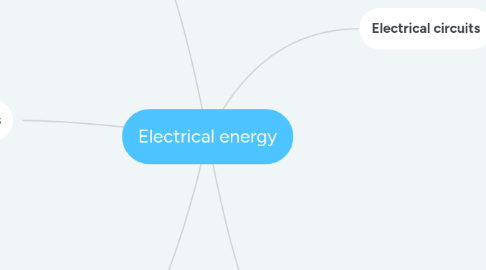
1. Electrical circuits
1.1. Common Symbols
1.1.1. https://www.google.com.au/url?sa=i&rct=j&q=&esrc=s&source=images&cd=&cad=rja&uact=8&ved=0ahUKEwjB9NHuprXXAhVEPrwKHUsYCO0QjRwIBw&url=http%3A%2F%2Fwww.bbc.co.uk%2Fbitesize%2Fks3%2Fscience%2Fenergy_electricity_forces%2Felectric_current_voltage%2Frevision%2F3%2F&psig=AOvVaw0HLCgEs166HxCytPKNjchl&ust=1510447810743594
1.2. Voltage
1.2.1. is a measure of the amount of energy supplied to the charges by the voltage source.
1.2.2. Used by components such as a light globe (voltage drop)
1.2.3. Volts
1.2.4. Voltmeter
1.3. Current
1.3.1. An electrical current is formed whenever charge flows from one point to another.
1.3.2. Current is high if a lot of charge flows through it.
1.3.3. Amperes
1.3.4. Ammeter
1.4. Resistance
1.4.1. Ohms
1.4.2. Multimeter
1.4.3. Measures how difficult it is for an electric current to pass through a material or a component.
1.5. Transformer:
1.5.1. Reduce voltage to a more manageable voltage.
1.6. Power
1.6.1. Watts= VA
2. Conductors and Insulators
2.1. Conductors
2.1.1. Easy for electricity to pass through
2.1.2. usually metals
2.2. Insulators
2.2.1. high resistance
2.2.2. Usually non Metals
3. Ohms Law
3.1. V= IR
3.2. I=V/R
3.3. R=V/I
3.4. https://www.google.com.au/url?sa=i&rct=j&q=&esrc=s&source=images&cd=&cad=rja&uact=8&ved=0ahUKEwjBkvj0qrXXAhVLXrwKHSsBDZAQjRwIBw&url=https%3A%2F%2Fwww.technologyuk.net%2Fphysics%2Felectrical-principles%2Fohms-law.shtml&psig=AOvVaw07IAif1OPWqdR4Vrba5tM0&ust=1510448932501549
4. Parallel and Series circuits
4.1. Series circuit
4.1.1. Are easy to connect but are often not very practical. This is because:
4.1.1.1. You cannot turn off any globes in the circuit individually.
4.1.1.2. If a globe 'blows' then that breaks the whole circuit. This makes it extremely difficult to find which globe blew.
4.1.1.3. Adding more globes reduces how brightly they glow. Each globe will be duller than the one before it.
4.2. Parallel Circuit;
4.2.1. In Parallel Circuits;
4.2.1.1. Each branch can have its own switch this allows each globe to be turned on and off independently.
4.2.1.2. only one branch is affected if a globe blows.
4.2.1.3. Adding extra globes does not affect their brightness.
5. Safety Devices in Households
5.1. Fuses: A fuse is a wire of high resistance and low melting point. It will melt if too much current flows through it. Melting breaks the circuit
5.2. Safety switches
5.2.1. They monitor how much current is flowing through them. The current flowing into the house should be the same as the current flowing out. If its not that means there is either a leak in a faulty appliance or you're getting electrocuted. It cuts the circuit in 0.03 seconds.
5.3. Circuit breaker
5.3.1. They switch if the current gets to high

